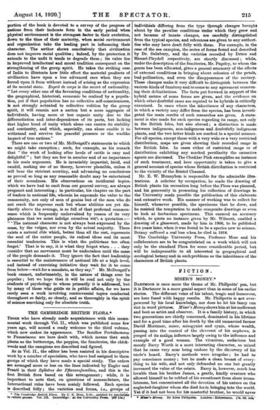THE CAMBRIDGE BRITISH FLORA.* Terosz who have already made acquaintance
with this monu- mental work through Vol. II., which was published some few years ago, will accord a ready welcome to the third volume, which now makes its appearance. The families Portulacacex to Femariaceae are here dealt with, which means that such plants as the buttercups, the poppies, the feraitories, the chick- weeds and the tampions are described and figured.
As in Vol. II., the editor has been assisted in his descriptive work by a number of specialists, who have had assigned to them groups of which they have made a special study. The orders are arranged more or less on the lines indicated by Engler and Prantl in their Syllabus der Pflanzenfamiltien, and this is the first British flora based on this arrangement ; while, it is important to note that, on questions of nomenclature, the International rules have been mainly followed. Each species is described fully ; the varieties and forms, i.e., groups of The Cambridge British Fiera By U. E. Moss. D.Sc., assisted by specialists in certain genera. Vol. La. Cambridge : at the University Press. [56 15s.]
individuals differing from the type through changes brought about by the peculiar conditions under which they grow and not because of innate changes, are carefully distinguished from the typical species, and references are given to any authori- ties who may have dealt fully with them. For example, in the case of the sea tampion, the series of forms found and described by Dr. Salisbury, and the varieties recorded by Druee and Mansel-Pleydell respectively, are shortly discussed ;
Under the description of the fumitories, Mr. Pugsley, to whom the genus has been allocated, gives a general summary of the effects of external conditions in bringing about cohesion of the petals, bud-pollination, and even the disappearance of the nectary. These changes make it very difficult to distinguish between the various kinds of fumitory and to come to any agreement concern- ing their delimitations. The facts put forward in support of the hybrid nature of some forms are given, and the evidence on which other doubtful cases are reputed to be hybrids is critically examined. In cases where the inheritance of any characters, in which a variety may differ from the species, has been investi- gated the main results of such researches are given. A state- ment is also made for each species regarding its range, not only in the British Isles, but also abroad ; a distinction is made between indigenous, non-indigenous and doubtfully indigenous plants, and the two latter kinds are marked in a special manner. For all species, except those with a very wide or a very restricted distribution, maps are given showing their recorded range in the British Isles. In cases either of restricted range or of distribution exhibiting any marked peculiarity the causative agents are discussed. The Cheddar Pink exemplifies an instance of such treatment, and here opportunity is taken to give a general account of species whose British distribution is restricted to the vicinity of the Bristol Channel.
Mr. E. W. Hunnybrin is responsible for the admirable inns- trations. A solicitor by occupation, he made the drawing of British plants his recreation long before the Flora was planned, and his generosity in presenting his collection of drawings to the University made possible the publication of this elaborate and extensive work. His manner of working was to collect for himself, whenever possible, the specimens that he drew, and he resisted the temptation to make composite drawings or even to look at herbarium specimens. This ensured an accuracy which, to quote an instance given by Mr. Wilmott, enabled a drawing of a glasswort, made by him in 1906, to be published five years later, when it was found to be a species new to science. Botany suffered a real loss when he died in 1918.
The Cambridge University Press, Professor Moss and his collaborators are to be congratulated on a work which will not only be the standard Flora for some considerable period, but will be indispensable to all interested in geographical and °ecological botany and• in such problems as the inheritance of the characters of British plants.


































 Previous page
Previous page